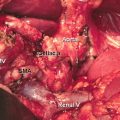TNM classification (UICC/AJCC 7th edition)
Primary tumor (T)
TX
Primary tumor cannot be assessed
T0
No evidence of primary tumor
Tis
Carcinoma in situ (including lesions classified as PanIn III)
T1
Tumor limited to the pancreas, 2 cm or less in greatest dimension
T2
Tumor limited to the pancreas, more than 2 cm in greatest dimension
T3
Tumor extends beyond the pancreas but without involvement of celiac axis or the superior mesenteric artery
T4
Tumor involves celiac axis or the superior mesenteric artery
Regional lymph nodes (N)
NX
Regional lymph nodes cannot be assessed
N0
No regional lymph node metastasis
N1
Regional lymph node metastasis
Distant metastasis (M)
M0
No distant metastasis
M1
Distant metastasis
Staging
Stage 0
Tis
N0
M0
Stage IA
T1
N0
M0
Stage IB
T2
N0
M0
Stage IIA
T3
N0
M0
Stage IIB
T1–3
N1
M0
Stage III
T4
Any N
M0
Stage IV
Any T
Any N
M1
The N (regional lymph nodes) staging is classified as N0 or N1 based on the presence or absence of regional lymph node metastasis. The M (distant metastasis) staging is classified as M0 or M1 based on the presence or absence of distant metastasis such as liver, peritoneum, lung, and bone metastases.
Tumors localized to the pancreas are classified in stage I (T1-2, N0, M0). Tumors extending to adjacent organs or involving regional lymph node metastases without distant metastases or invasion into celiac axis or superior mesenteric vein are classified in stage II (T3, N0, M0 or T1-3, N1, M0). Locally advanced Tumors involves celiac axis or superior mesenteric vein without distant metastases are classified in stage III (T4, any N, M0). Tumors with distant metastases at the time of diagnosis are classified in stage IV (any T, any N, M1).
The combination of T, N, and M into stage groupings accurately reflects the differences in prognosis among patients with resectable, locally advanced, and distant metastatic disease. Matthew H. G. Katz et al. previously reported the 6th edition of the AJCC TMN staging system applied to 2981 patients with pancreatic adenocarcinoma evaluated at MD Anderson Cancer Center between August 1996 and August 2006 [5]. In this report, median survival of patients who initially presented with resectable (stage I/II), locally advanced (stage III), and metastatic disease (stage IV) was 15 months, 11 months, and 6 months, respectively. Bilimoria, K. Y. et al. also reported that by using the National Cancer Database (1992–1998), 121,713 patients were identified with pancreatic adenocarcinoma. All patients were restaged by AJCC 6th edition guidelines. Stage-specific overall survival was estimated by using the Kaplan-Meier method and compared with log-rank tests. Concordance indices were calculated to evaluate the discriminatory power of the staging system. Cox modeling was used to determine the relative impact of T, N, and M classification on survival. For all patients, there was 5-year survival discrimination by stage (P < 0.0001). For patients who underwent pancreatectomy, stage predicted 5-year survival: stage IA, 31.4%; IB, 27.2%; IIA, 15.7%; IIB, 7.7%; III, 6.8%; and IV, 2.8% (P < 0.0001) (Table 10.2). The concordance index for the staging system was 0.631 for all patients, 0.613 for those who underwent pancreatectomy, and 0.596 for patients who did not undergo resection. In patients who underwent pancreatectomy, tumor size, nodal status, and distant metastases were independent predictors of survival (P < 0.0001) [6].
Table 10.2
Five-year overall survival for resected pancreatic adenocarcinoma from the National Cancer Database (1992–1998, at a time when adjuvant therapy was not typically administered)
Stage | Number of patients | % | 5-year survival (%) | Median survival (months) |
|---|---|---|---|---|
IA | 1886 | 8.8 | 31.4 | 24.1 |
IB | 2364 | 11.0 | 27.2 | 20.6 |
IIA | 3846 | 17.9 | 15.7 | 15.4 |
IIB | 7828 | 36.4 | 7.7 | 12.7 |
III | 2850 | 13.2 | 6.8 | 10.6 |
IV | 2738 | 12.7 | 2.8 | 4.5 |
Total | 21,512 | 12.6 |
Prognostic factors in stage I and stage II are tumor size and lymph node status. Pathologically measured tumor size in greatest dimension was significant independent prognostic factor in previous reports about the patients with resected pancreatic ductal adenocarcinoma after pancreaticoduodenectomy [7–12] (Table 10.3). In most of these reports, the cutoff size was between 2 cm and 3 cm with significant differences in prognosis. Although the survival of patients with small pancreatic cancers was more favorable, 41% of tumors up to 2 cm in diameter had lymph node metastases [9]. Therefore, T1 tumors are not necessarily early-stage disease.
Table 10.3
Correlation between tumor size and survival
Institution (country) | Diameter of tumor | Number of patients (%) | 5-year survival (%) | Median survival (months) | P |
|---|---|---|---|---|---|
University of Naples (Italy) | >3 | 34 (51) | 9 | 11 | 0.006 |
<3 | 33 (49) | 33 | 18 | ||
Jagiellonian University (Poland) | >2 | NR (94) | NR | 26 | 0.04 |
≤2 | NR (6) | NR | 46 | ||
Nuremberg (Germany) | >2 | 80 (78) | 5 | 13 | 0.001 |
≤2 | 22 (22) | 19 | 25 | ||
Harvard School of Public Health (USA) | >2 | 239 (77) | NR | 15 | 0.002 |
≤2 | 70 (23) | NR | 38 | ||
Kansai Medical University (Japan) | ≥3 | 57 (63) | 7 | 8 | 0.006 |
<3 | 33 (37) | 26 | 22 | ||
Johns Hopkins University (USA) | ≥3 | NR | 4 | 15 | <0.0001 |
<3 | NR | 23 | 21 |
Pathologically metastasis to regional lymph nodes was also significant independent prognostic factor in previous reports about the patients with resected pancreatic ductal adenocarcinoma after pancreatic resection (Table 10.4) [7–15]. Considering its prognostic significance, TNM staging system classifies node-positive tumors as stage IIb.
Table 10.4




Correlation between lymph node status and survival
Stay updated, free articles. Join our Telegram channel

Full access? Get Clinical Tree






